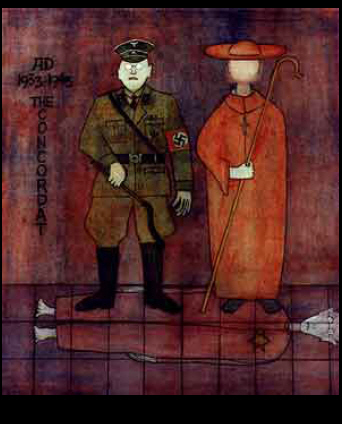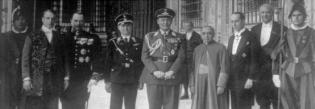About the Reichskonkordat
The Reichskonkordat was signed in Rome as the bells of St. Peter's rang out. Both sides saw themselves as the winners. And both sides were glad to be free of the independent, democratic Catholic Centre Party which had been dissolved during the negotiations. Now the German Catholics were being told it was their Christian duty to support Hitler.

Fritz Hirschberger, a Holocaust survivor,
painted a Nazi officer and a faceless Cardinal (Pacelli)
standing on the body of a Jewish prisoner.
He titled it "The Concordat".
.
The evidence suggests that German Catholics — a third of the population — were marshalled to support Hitler through a top-down operation directed by the Vatican.
It wasn't the Catholic laymen who first went over to Hitler, then the bishops, then the Curia. Instead, the Curia decided to repeat the successful experiment with Mussolini, the German bishops obeyed and the faithful had to follow. [1]
On the 4th of January 1933 there was a secret meeting at the home of the Cologne banker and Nazi member, Kurt Baron von Schröder. There Hitler met with Franz Baron von Papen, who was at that time both German Chancellor and Papal Chamberlain. The postwar testimony of Schröder at the Nuremberg trials implies that this secret session, with only the trusted intermediary present, was set up to let Von Papen promise Hitler the support of Pope Pius XI and demand in return the destruction of the communist and social democratic parties and the conclusion of a concordat. [2]
After that, everything quickly fell into place. Hitler seized power through the Enabling Act of 24 March 1933, which suspended democratic rule. He did this with the help of the Catholic Centre Party, which then got out of his way by dissolving itself, That let Hitler suspend democratic freedoms "until further notice" and the Nazi terror began. The concordat, which would normally have taken years, was negotiated, signed and ratified well before the end of the year.
In these early months of 1933, Catholic leaders went from being Hitler's staunch opponents to his latest allies. This transformation was dramatically symbolized by the fact that in 1932, the Fulda Episcopal Conference, representing the Catholic hierarchy of Germany, banned membership in the Nazi Party" and forbade priests from offering communion to anyone wearing the swastika; then, on March 28, 1933, two weeks after Pacelli offered his overture to Hitler, the same Fulda conferees voted to lift the ban on Catholic membership in the Nazi Party. The bishops expressed, as they put it, 'a certain confidence in the new government, subject to reservations concerning some religious and moral lapses.' Swastika bearers would now be welcomed at the communion rail. [3]

Hermann Göring, centre, about to be taken by
Monsignor Caccia Dominioni, the Papal Maestro di
Camera, into an audience with Pope Pius XI on 12 April
1933, as part of negotiations for the Concordat.
Cardinal Faulhaber, on his return from a trip to the Vatican, reported in Berlin on the 25th of April 1933 that
In Rome National Socialism, like Fascism, is regarded as the only salvation from Communism and Bolshevism. The Holy Father regards that from a distance, doesn't see the concomitants, only the great aim. [4]
The "concomitants" — what would today be called "collateral damage" — were the destruction of democracy, mounting terror and the beginning of a campaign of genocide. The Vatican's "great aim" included got the concordat that previous, democratic, German governments had refused to grant.
Each side thought it was getting the better deal. As Hitler cynically put it:
"We should trap the priests by their notorious greed and self indulgence. We shall thus be able to settle everything with them in perfect peace and harmony. I shall give them a few years' reprieve. Why should we quarrel? They will swallow anything in order to keep their material advantages. Matters will never come to a head. They will recognize a firm will, and we need only show them once or twice who is master. They will know which way the wind blows." [5]
German Catholics misled by their Church
This marriage of convenience between Hitler and the Church hierarchy was deeply confusing to German Catholics who looked to their church for guidance. Hitler’s 1933 election posters for Catholics told them that it was their religious duty to support his party, and the Church did nothing to counter this impression.
Jared Israel explains the signals they received when Hitler was granted a concordat:
"Put yourself in the position of a 1933 German Catholic as you read the text of the Concordat between Nazi Germany and the Vatican, the Reichskonkordat.
"The German Catholic Church has rescinded its ban on joining the Nazi Party. The Catholic Centre party has dissolved itself. [And Articles 31 and 32 prevent any revival of this democratic Catholic party which had opposed the Nazis.] In the Reichskonkordat, the Vatican has promised that German Bishops and their subordinates will be obedient to and honour the Nazi state (Article 16). It has promised that German Catholic educators will teach children patriotic love for the Nazi state (Article 21). It has requested and received the Nazi dictatorship's promise to enforce internal Church decisions (Article 10). Cardinal Bertram of Breslau has called on Catholics to avoid all subversive or illegal (by Nazi definition) activities.
"How should you respond to the Nazi's new nightmare state? Doesn't the Catholic Church teach you to view Church officials as exemplary? Shouldn't they be emulated? Isn't the Pope's word law, and didn't the Pope sign the Reichskonkordat, an agreement with the Nazi dictatorship, that [in Article 16 contains this pledge for new bishops]:
In the performance of my spiritual office and in my solicitude for the welfare and the interests of the German Reich, I will endeavour to avoid all detrimental acts which might endanger it. [6]
In other words, the impetus for the Catholic faithful to follow Hitler came from above.
It wasn't the Catholic laymen who first went over to Hitler, then the bishops, then the Curia. Instead, the Curia decided to repeat the successful experiment with Mussolini, the German bishops obeyed and the faithful had to folllow. [7]
The concordat lives on
After the war the concordat was cleverly anchored in the new German Constitution. [8] Article 123.2 says that "State treaties concluded by the German Reich" must be honoured so long as these concern areas which fall under the competence of the individual German states. Later the papal nuncio complained to the Federal Government that Lower Saxony was not complying with some provisions of the Concordat. Although the states of Hesse and Bremen also wanted to scrap the concordat, the Federal Government supported the nuncio by bringing the matter before the Constitutional Court.In 1957 it ruled that, though the regime had changed, the state remained the same and therefore the concordat would continue in force in Germany. [9]
After WWII the Allied Powers took the precaution of decentralising Germany by making the powers of the federal states (Länder) very wide, even letting them share jurisdiction with the national government in key areas like finance. And so it was meant to remain, for Art. 79.3 of the Constitution explicitly forbade any future change in the division of the Federation into Länder and any change in their powers. Germany is constitutionally locked into decentralisation — and also into the 1933 concordat.
The broad legal competencies given to the individual German states by the 1949 Constitution encompass key areas of interest to the Church such as culture, education, social services and (some aspects of) finance. This allows the states to take over these parts of the Hitler concordat, thus preserving most of the last surviving concordat with a Fascist government. This has also made the concordat unassailable without a constitutional upheaval and has served to build it into the fabric of German law.
Secret Supplement hints at Vatican plans
The concordat includes the Secret Supplement. Naturally, this is omitted on Catholic sites because it shows that by 1933 the Vatican knew that Hitler was going to re-arm in defiance of the Treaty of Versailles, and the Church wanted to help him keep it secret. In fact, the Secret Supplement of the Austrian concordat indicates that two years earlier the Vatican was already planning for this eventuality.
 The reason is clear. Already in 1929, the year Pacelli was appointed Secretary of State, the Vatican had set up an ambitious programme to train missionaries for the USSR and when Hitler invaded Russia in 1941 these priests set off for the East. [10]
The reason is clear. Already in 1929, the year Pacelli was appointed Secretary of State, the Vatican had set up an ambitious programme to train missionaries for the USSR and when Hitler invaded Russia in 1941 these priests set off for the East. [10]
This helps to explain Pius' shabby treatment of the Poles. After the invasion of Poland by the Germans the Vatican broke the Polish Concordat by appointing a foreign bishop — a German, no less — over a part of Polish territory. In the minds of many this helped to legalise the German occupation. In fact, it has been argued that the Vatican supported the Nazis and viewed their planned conquest of Catholic Poland as collateral damage. This is because the German 1941 military campaign against Russia, if successful, would have opened up the prospect of the conversion of Russia to Catholicism. [11] Thus the Secret Supplement, which quietly provided for an illegal German re-armament, looks like a very shrewd piece of Vatican strategy.
See also: Highlights from the long history of Christian anti-Judaism: compare Canon (Church) Law and Nazi antisemitic measures.
Notes
1. Karlheinz Deschner, Mit Gott und dem Führer: Die Politik der Päpste zur Zeit des Nationalsozialismus, p. 34. This book (which can be downloaded on this page) is a selection (minus the footnotes) from his two-volume Ein Jahrhundert Heilsgeschichte. Die Politik
der Päpste im Zeitalter der Weltkriege (1982/83).
2. Deschner, pp. 34-35.
3. James Carroll, Constantine's Sword: The Church and the Jews - A History, 2001, p. 498.
4. Deschner, p. 40.
5. Quoted in Guenter Lewy, The Catholic Church and Nazi Germany (2000), pp. 25-26.
6. Jared Israel, The Vatican Made Nazism Possible in Germany and Croatia, Emperor's Clothes, 22 April 2005. http://emperors-clothes.com/vatican/cpix.htm
7. An English translation of the German Constitution (“Basic Law”) posted at http://www.iuscomp.org/gla/statutes/GG.htm begins Article 123.2 as follows:
Subject to all rights and objections of interested parties, treaties concluded by the German Reich concerning matters within the legislative competence of the Länder under this Basic Law shall remain in force [...].
In other words, in any area under the legal competence of the German states (Länder), the 1933 Concordat is still valid. And since the legal competence of the German states is very broad (see Art. 70-74), this means that most of this “treaty” remains in force. The German original can be found at: http://www.bundesregierung.de/pureHtml-,413.429858/Grundgesetz-fuer-die-Bundesrep.htm
8. See §4(a) of the judgement in German, BVerfGE 6, 309 - Reichskonkordat. http://www.servat.unibe.ch/dfr/bv006309.html
A summary of the Constitutional Court's 1957 judgement on the Concordat is given in the German Wikipedia: http://de.wikipedia.org/wiki/Reichskonkordat#Das_Konkordatsurteil_des_Bundesverfassungsgerichts
9. In fact, Art. 72.1 of the postwar Constitution gave the states all competencies not explicitly assigned to the national government. Cf., Christian Lorenz, "Des Grundgesetzes politische und rechtsstaatliche Kosten", 5 (a). http://www.staatsbriefe.de/1994/1999/lorenz.htm
10. John Cornwell, Hitler's Pope, 1999, pp. 263-64. http://pt.scribd.com/doc/81219132/Hitler-s-Pope-John-Cornwell
11. Carlo Falconi, El Silencio de Pio XII, 1970, p. 250. http://pt.scribd.com/doc/80703427/Carlo-Falconi-El-Silencio-de-Pio-XII







 Hitler's concordat (1933) : Text and background
Hitler's concordat (1933) : Text and background